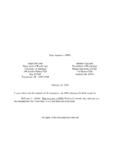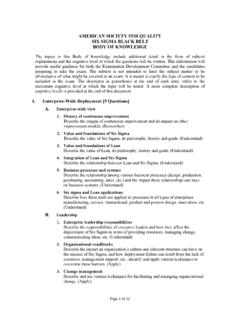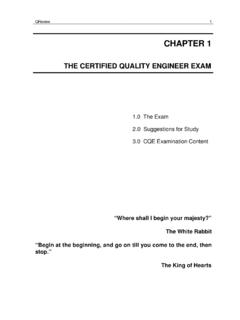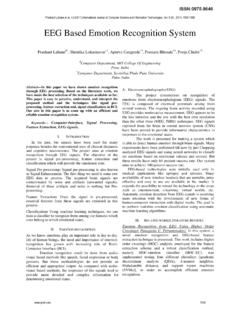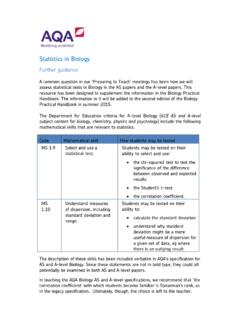Transcription of 155-2012: How to Perform and Interpret Chi-Square and T …
1 SAS Global Forum 2012 Hands-on Workshops Paper 155-2012. How to Perform and Interpret Chi-Square and T-Tests Jennifer L. Waller Georgia Health Sciences University, Augusta, Georgia ABSTRACT. For both statisticians and non-statisticians, knowing what data look like before more rigorous analyses is key to understanding what analyses can and should be performed. After all data have been cleaned up, descriptive statistics have been calculated and before more rigorous statistical analysis begins, it is a good idea to Perform some basic inferential statistical tests such as Chi-Square and t-tests.
2 This workshop concentrates on how to Perform and Interpret basic Chi-Square , and one- and two-sample t-tests. Additionally, how to plot your data using some of the statistical graphics options in SAS will be introduced. INTRODUCTION. Millions of dollars each year are given to researchers to collect various types of data to aid in advancing science just a little more. Data is collected, entered, cleaned, and a statistician is told it is ready for analysis. When a statistician receives data, there are some basic statistical analyses that are performed first so that the statistician understands what the data look like.
3 Statisticians examine distributions of categorical and continuous data to look for small frequency of occurrence, amount of missing data, skewness, variability and potential relationships. Not understanding what the data look like in their basic form can cause incorrect assumptions to be made and an incorrect statistical analysis could be performed later on. The first look at a data set includes plotting the data, determining appropriate descriptive statistics, and performing some basic inferential statistics like t-tests and chi- square tests. Knowing what descriptive statistic or inferential statistical analysis is appropriate for the type of variable or variables in the data, how to get SAS to calculate the appropriate statistics, and what are the necessary things to report off the output is essential.
4 SAS has a whole host of statistical analysis tools for both descriptive and inferential statistical analyses. DESCRIPTIVE STATISTICS. What are descriptive statistics? These are numbers that describe your data and the type of descriptive statistic that should be calculated depends on the type of variable being analyzed: categorical, ordinal, or continuous. Categorical Variables Categorical data is data that can take on a discrete number of values or categories with no inherent order to the categories. Examples of categorical variables are sex (male or female), race (Black, White, Asian, Hispanic), disease or no disease, and yes or no variables.
5 The types of descriptive statistics that are calculated for categorical variables 1. SAS Global Forum 2012 Hands-on Workshops include frequencies and proportions or percentages in the various categories of the variable. Ordinal Variables Ordinal variables are another type of variable where there are a discrete number of values but the values have some inherent order to them. For example, Likert scale variables (strongly disagree, disagree, agree to strongly agree) are ordinal variables. There is an inherent knowledge that strongly disagree is worse than disagree. Several types of descriptive statistics can be calculated for these types of variables including frequencies and proportions or percentages, medians, modes, inter-quartile range.
6 Depending on the number of values an ordinal variable can take on, a mean and standard deviation may also be calculated. Continuous Variables Continuous variables are those for which the values can take on an infinite number of values in a given range. While we may not be able to actually measure the variable as precisely as we would wish, the potential number of values is infinite. For example, think about measuring height. We record height in inches or meters and we measure height with a ruler of some sort. But we are limited in how precise height is measured due to our measuring device.
7 Is someone really 5 feet 7 inches or are they really inches. We know that height is measured in a given range and that there really are an infinite number of values that height can take on, but the precision of our measurement is at the mercy of our measuring device. Descriptive statistics that are appropriate for a continuous measure include means, medians, modes, quartiles, variances, standard deviations, coefficients of variation, ranges, minimums, maximums, kurtosis, skewness, inter-quartile ranges, and the list goes on. Inferential Statistics Inferential statistics are used to examine data for differences, associations, and relationships to answer hypotheses.
8 The types of inferential statistics that should be used depend on the nature of the variables that will be used in the analysis. The most basic inferential statistics tests that are used include Chi-Square tests and one- and two- sample t-tests. Chi-Square Tests A Chi-Square test is used to examine the association between two categorical variables. While there are many different types of Chi-Square tests, the two most often used as a beginning look at potential associations between categorical variables are a Chi-Square test of independence or a Chi-Square test of homogeneity. A Chi-Square test of independence is used to determine if two variables are related.
9 A Chi-Square test of homogeneity is used to determine if the distribution of one categorical variable is similar or different across the levels of a second categorical variable. One- and Two-Sample T-tests T-tests are used to examine differences between means. A one-sample t-test is used to examine whether the sample mean of a single continuous variable in a single group of individuals is different from a particular hypothesized population value. A two-sample t- 2. SAS Global Forum 2012 Hands-on Workshops test is used to examine whether the sample mean of a single continuous variable is different between two different groups of individuals.
10 THE DATA SET. Before introducing the statistical procedures in SAS which are used to calculated descriptive statistics and Perform Chi-Square and t-tests, the data set that will be used throughout the rest of the paper will be discussed. The data set comes from the book, A Handbook of Small Data Sets by Hand et al. (1994) page 266 dataset number 328. The description from the book is as follows: The data come from the 1990 Pilot Surf/Health Study of NSW Water Board. The first column takes on values 1 or 2 according to the recruit's perception of whether (s)he is a Frequent Ocean Swimmer, the second column has values 1 or 4 according to the recruit's usually chosen swimming location (1 for non-beach 4 for beach), the third column has values 2 (aged 15-19), 3 (aged 20-25) or 4 (aged 25-29), the fourth column has values 1 (male) or 2 (female), and, finally, the fifth column has the number of self- diagnosed ear infections that were reported by the recruit.











